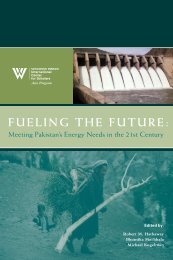Environmental Change and Security Project Report - Woodrow ...
Environmental Change and Security Project Report - Woodrow ...
Environmental Change and Security Project Report - Woodrow ...
You also want an ePaper? Increase the reach of your titles
YUMPU automatically turns print PDFs into web optimized ePapers that Google loves.
86<br />
mental legislation. In 1980, Speth released<br />
CEQ’s Global 2000 <strong>Report</strong> to the President, a<br />
seminal work that brought global warming to<br />
the public consciousness, part of an apparently<br />
rising tide of environmental awareness <strong>and</strong><br />
action. In hindsight, however, its publication<br />
at the end of the Carter administration was the<br />
high-water mark of the American environmental<br />
era.<br />
In the 1960s <strong>and</strong> 1970s, as Speth relates, new<br />
environmental laws targeted the low-hanging<br />
fruit. Since then, there have been a few startling<br />
successes, such as the Montreal Protocol, but on<br />
most critical issues like biodiversity <strong>and</strong> climate<br />
change, we have been treading water—or worse.<br />
Speth reminds us that nearly all of the environmental<br />
problems now facing the world have<br />
been known for a quarter century. He laments<br />
that “little has been done…. If I were a young<br />
person being h<strong>and</strong>ed this problem by indulgent<br />
predecessors, I would be angry” (page 5).<br />
Drivers <strong>and</strong> Solutions<br />
In the second half of his book, Speth provides a<br />
convincing depiction of 10 drivers of environmental<br />
destruction (population, affluence,<br />
technology, poverty, market failure, policy <strong>and</strong><br />
political failure, economic growth, the economic<br />
system, our culture <strong>and</strong> values, <strong>and</strong> globalization).<br />
This thorough but daunting list encompasses<br />
almost the entire human endeavor.<br />
However, although Speth spends several pages<br />
describing the environmental challenges of<br />
continuing global population growth, he curiously<br />
omits any mention of U.S. growth,<br />
which, at more than three million people per<br />
year, surpasses all but China <strong>and</strong> India (<strong>and</strong><br />
trumps both of these giants in terms of environmental<br />
impact).<br />
To confront these various threats, Speth says,<br />
“The principal way to a sustainable world is to<br />
apply major resources of time <strong>and</strong> money to the<br />
promotion of eight broad, linked transitions<br />
that seek to define <strong>and</strong> redirect growth” (page<br />
152), such as transitioning to environmentally<br />
benign technologies, environmentally honest<br />
prices, sustainable consumption, a stable or<br />
smaller world population, <strong>and</strong> a world free of<br />
mass poverty.<br />
These utopian ideas are attractive, but the<br />
language <strong>and</strong> suggested means may appeal more<br />
to policy wonks than revolutionaries. Freedom<br />
from mass poverty, environmentally benign<br />
technologies, <strong>and</strong> environmentally honest<br />
prices, for example, can only be actualized (if at<br />
all) by big government, large NGOs, top-down<br />
policies, <strong>and</strong> well-connected cognoscenti. These<br />
are the same forces that Speth criticizes for failing<br />
to get the job done over the last several<br />
decades. So when he suggests that citizen<br />
activists contribute to hundreds of environmental<br />
organizations (listed—but frustratingly<br />
unranked—in the book’s final section), it is<br />
both overwhelming <strong>and</strong> a little anticlimactic. If<br />
that approach has not worked for the last 30<br />
years, why will it work in the future?<br />
Gr<strong>and</strong> Old Men<br />
The Economist (2004) called Speth “one of the<br />
gr<strong>and</strong> old men of greenery.” Therein lies his<br />
great wisdom <strong>and</strong> genuine appeal, but also the<br />
root of the environmental movement’s most<br />
serious problem: it has aged, growing from its<br />
strident, bold, <strong>and</strong> energetic youth into a more<br />
conservative, cautious, <strong>and</strong> sometimes resigned<br />
middle age. In the 1970s, the scruffy, chaotic,<br />
shoestring atmosphere of the World Wildlife<br />
ECSP REPORT • ISSUE 10 • 2004

















